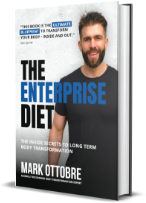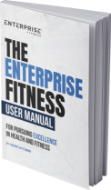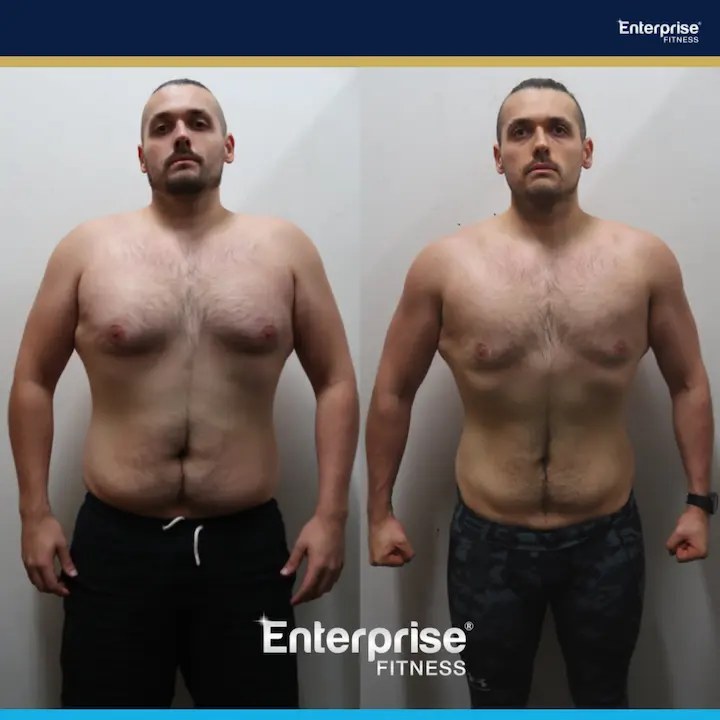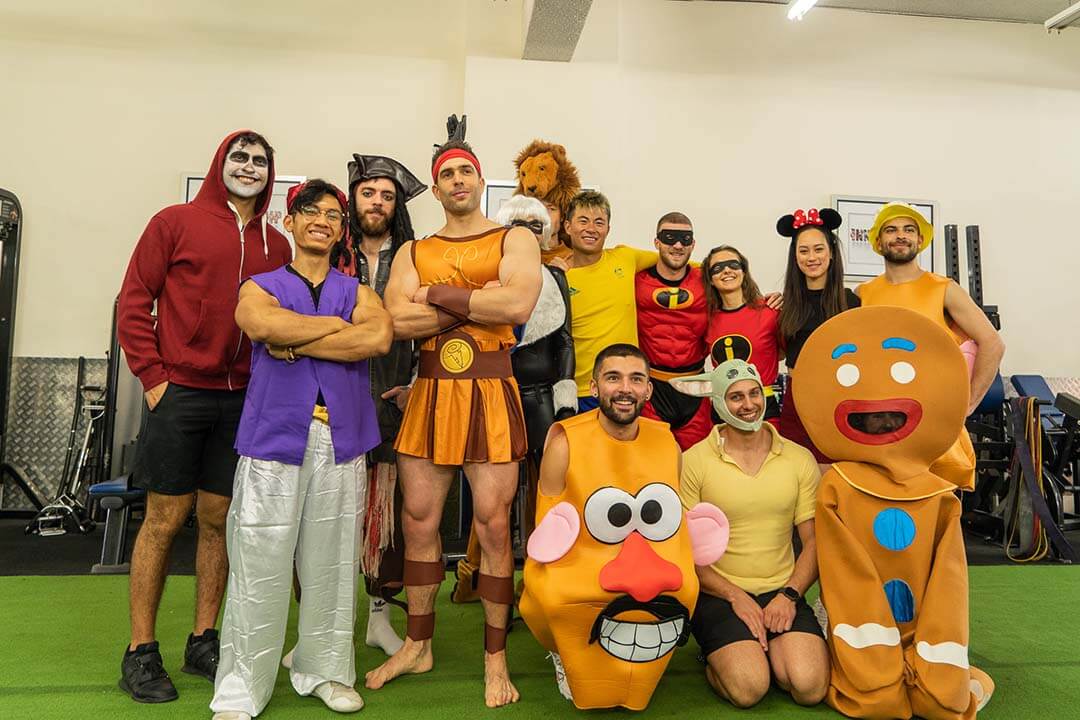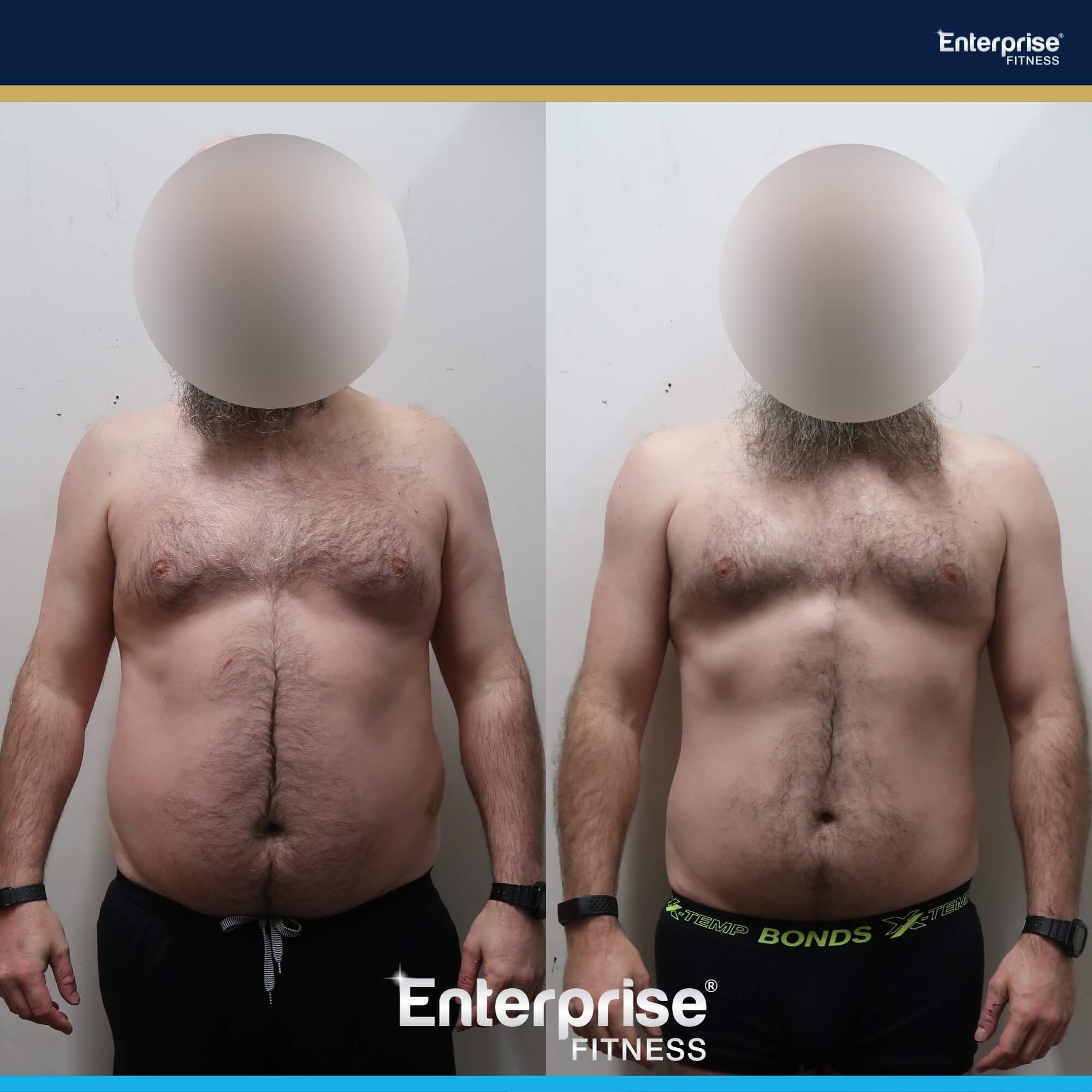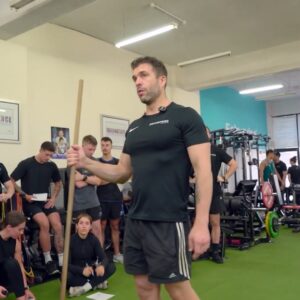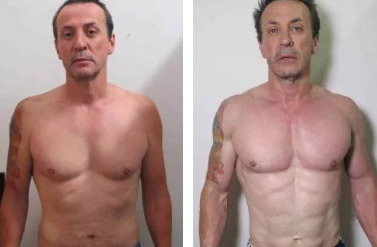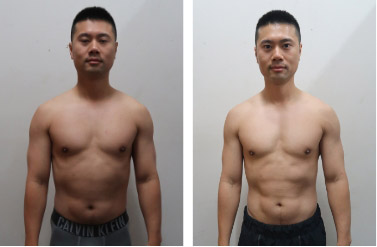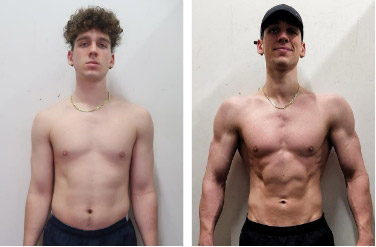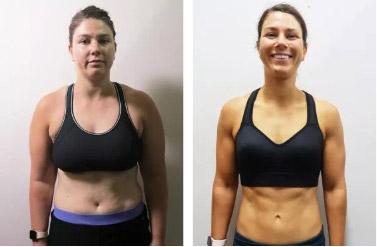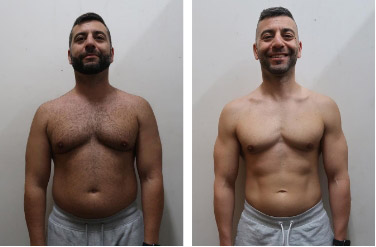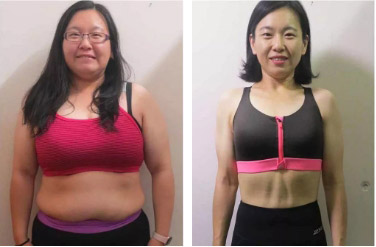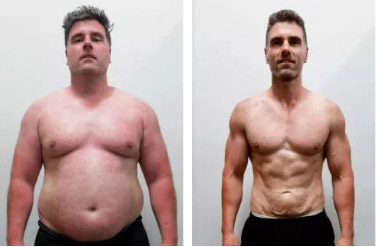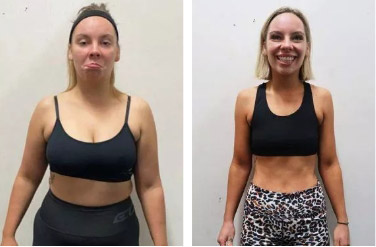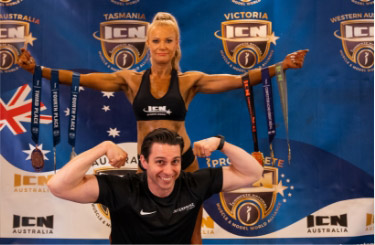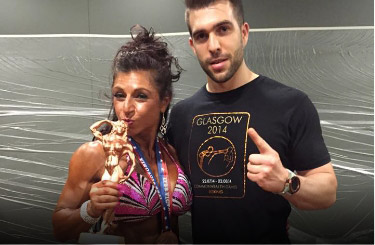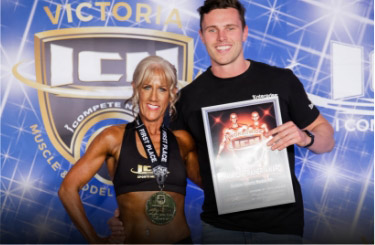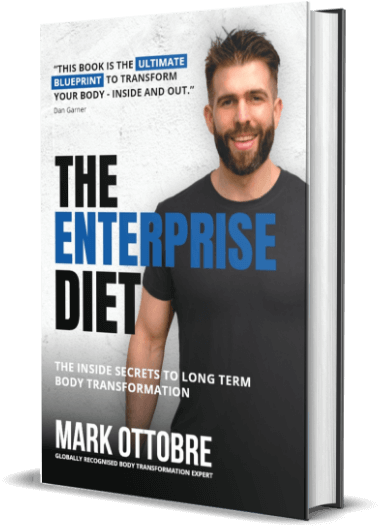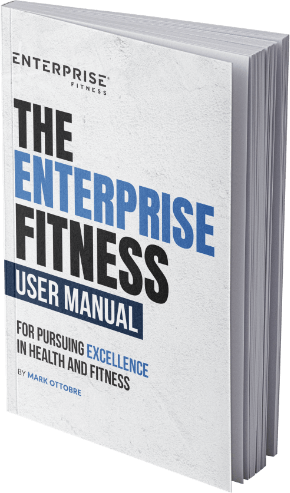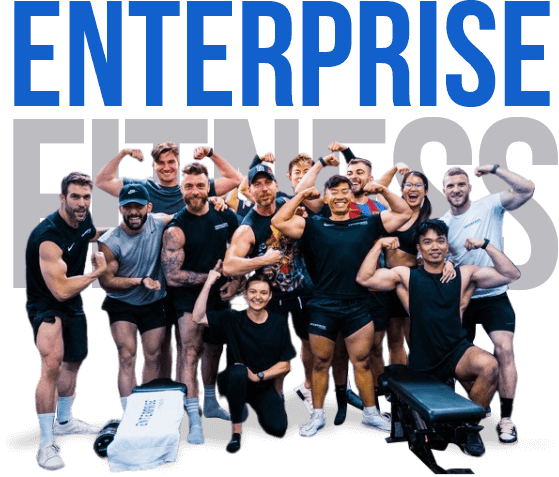Enjoy this full presenation on Nutrition for Bodybuilders by Enterprise Coach, Reece Adams.
For convenience, the full transcription is below with timestamps to each segment:
Mark Ottobre: 00:00:00 Alright, welcome back to Wolfpack, April edition. Reece obviously presented in February on macros, and you all seemed to have very much enjoy that. He’s back today talking about presentations entitled Nutrition for Hypertrophy, How Not to Just Get Fat, and we’ll be debunking a lot of the myths around bulking, and getting lean, and we’ll hold different case studies that he’s got included in this. As always let’s give him a nice warm welcome. And you can take it away Reece.
Reece Adams: 00:00:32 Thank you guys. The main take home point for this presentation is that is it possible to gain muscle whist in a deficit, that’s the main take home point, okay? So obviously eating a surplus is gonna encourage muscle gain. That is one of those things where do you necessarily need to eat in a surplus every day to gain muscle, yeah? That’s what we’re gonna cover.
00:00:56 The disclaimer, so we’re gonna read this for the presentation. The information contained in this presentation is for information purposes only. It does not constitute financial, legal, or medical advice. You should seek independent financial, legal, or medical advice before using any of the information in this presentation. Any views expressed by the third party are not necessarily endorsed by the presenter.
0:01:21 As you guys know, before we get stuck into it, any questions you have, please keep them to the end just so that things can flow. James had 15 slides, I’ve got 30, so there’s plenty to get through. As I like to do, I always like to give as much as possible, so we’ll get through it.
00:01:38 This is me as a kid. Everybody always laughs at me because my favorite dog is a Gray Hound or a Whippet, and they’re like, as you can see here, they’re like, “Oh you’ve got a decent amount of muscle and you like such a skinny dog.” It’s because my natural personality, that’s sort of how I grew up, so I can kind of relate to them and how timid they are and shy and things like that. That was me as a skinny kid. That’s how I grew up. Then obviously when we have a void we try to fill that, so want to get as massive ass possible, so that was me getting ready for my first competition I did.
00:02:17 Also what I also wanted to touch on this was basically what I’m gonna cover is my experience gaining muscle, coaches I’ve worked with, what I’ve learned from them, and also what I’ve used from clients I’ve found to work.
00:02:35 This is my first competition, so it’s one of those things where it’s not just always aby size because someone might come to you and they might say they want to put on muscle, and you might have this idea of they want to get massive, but that might not be their idea, so it’s one of those things where you might want to talk to your client and get an idea of what putting on muscle for them actually looks like, because otherwise you might lose your client if you don’t fully understand their goals. The learning outcomes. So the first one we’re gonna talk on, hypertrophy, what in basic terms what hypertrophy is, because when most people think of hypertrophy they think of just muscular hypertrophy, they don’t think of the actual definition of what actually hypertrophy is because there’s many forms of hypertrophy. Or should I say there’s many organs and tissues that you can create hypertrophy with, not just the gluteal muscle.
00:03:29 Also what we want to touch on is realistic expectations, because it’s so common when people come to us that, “Hey I want to put on 10 kilos and I want to do it this year.” Obviously depending on the individual is gonna dictate how fast they can put it on, but I’m sure you guys have heard that a lot and just kind of giving your client expectations of what is realistic based on if they’re a beginner, intermediate, or advanced.
00:03:55 How to establish the baseline in the context of gaining muscle and tracking progress, so you can’t really give a nutritional plan without having some form of a baseline and somewhere to go from. This also helps with having a baseline in when they might start to gain excessive amount of body fat so that you can pull them back to their baseline, allow them to reset, and then go again from there.
00:04:17 Also tracking progress. Is it possible to gain muscle in a deficit? What does the science say, and some real life examples of what I’ve used with my clients. Understanding adaptation and how to manipulate it. So adaptation is something that’s gonna happen, it’s inevitable, so it’s just understanding it and then what can we do to allow our clients to keep progressing when they’ve plateaued.
00:04:42 Sorry. I tend to walk. You did say that. Mark warned me. Okay. So what is hypertrophy? Hypertrophy is the enlargement of an organ or tissue from the increase in the size of the cells. Basically the cell size is getting bigger, that is hypertrophy, which means that if we’re talking about [scletal 00:05:03] muscle, the cell size of the scletal muscle is getting bigger.
00:05:10 Another example of this in my standard Reece fashion. I did say there’s other organs that this can work with, okay? One of these organs is the uterus for a female. What can happen is throughout pregnancy it can go from the size of an orange to the size of a watermelon. Just a fun fact. Just so that you guys, when you think of hypertrophy you don’t just think of muscle tissue, yeah? Hypertrophy can be in many forms.
Reece Adams: 00:05:34 In the prostate, it comes in many forms. In the bell wall, the bell walls can get more hypertrophied. It continues, yeah?
Speaker 3: 00:05:46 Gains of the bowels.
Reece Adams: 00:05:47 Gains of the bowels, okay? I just wanted to, because otherwise this presentation can be very dry. You might notice that I tend to put a bit of a spin on things.
Speaker 3: 00:05:47 [inaudible 00:06:00].
Reece Adams: 00:06:03 Okay. Moving on back to the dry stuff. In terms of what is realistic expectations of muscle gain, so a beginner in their first year, so what would deem a beginner? Someone who’s in their first year of training. Their new to training. They’re obviously gonna have newbie gains and they’re gonna get gains at a faster rate than what someone is experienced in training is gonna have.
00:06:24 These are some examples and you can see here I just thought I’d give you guys some reality of what it actually is, because these are percentages, so it’s like 1 to 1.5% of the body weight in pounds. But say we’ve got a hundred kilo guy. If he’s advanced, he could be looking at about 200 grams a month, okay? That’s not very exciting. So this is why it’s important to create this expectation with your clients. Obviously you’re gonna get variations of this because you’ve got your next involved and also programming and all of the above, so it’s an important thing to just understand the whole picture. We might use things like half a kilo or kilo a week is pretty good, but obviously that’s just a ball part figure.
00:07:12 Then with a female, so half the size most commonly, 125 grams if they’re advanced, so if they’re a beginner, 375 grams. Obviously it’s on a smaller scale, it’s a smaller frame. This was from Lyle McDonald’s book. Also something that’s important to notice is you might see these cases where guys put on five kilos of muscle in a week. This could be related to glycogen, so what’s happening is they’re in a depleted state, so all of a sudden their body weight jacks up because glycogen is one part glucose, three parts water, which then effects basically the numbers and gives the illusion that they gained an excessive amount of muscle.
00:07:55 This is where, when you have someone come to you, you might want to take into account what their current nutrition is like, because if they’re in an underfed state, they’re gonna have newbie gains when you start to feed them because now you’re supporting, you’re filling out their depleted tissue, so just keep in mind that obviously will come to an end once their body starts to basically get to the point where it’s filled out and then obviously the gains are gonna slow down.
00:08:25 And excess water retention, so they might think that they’ve put on three kilos in a week, but I’ll give the example of myself. So they may be holding water from a sudden stress, so an acute stress that I had was a motorbike accident. Put on three kilos that day, I didn’t change my nutrition, so that’s something to consider.
00:08:43 So if you’re like getting their body weight and they come in, they’re three kilos heavier, “Oh you gained three kilos this week!” Just something to consider, that there is variables.
00:08:56 How to establish a baseline in the context of gaining muscle. Hope is not a plan for success, so this is a good line by Mark, and what you’ll find is most people, they say I want to gain muscle, and then they just fall on this see food diet. They’re seeing food and they’re eating it, and yeah they’re gaining weight, but it’s not always gonna be muscle tissue.
00:09:17 That is partially gonna happen when the goal is gaining muscle, but obviously we want to minimize the extent at which what is body fat and what is muscle. So if you’re gaining fat at a faster rate than muscle, this kind of outweighs the benefit, because then when you go to get the fat off, your probably gonna lose a portion of that muscle in the process.
00:09:41 So ectomorphs tend to, typically ectomorphs, they’ll come to you and they’ll say, “I can’t gain any weight,” but what they’ll do is they’ll eat a heap of food, be they’ll give you the day that they ate a heap of food, but then they don’t take into account the days that they might have slept in and ate less that day because they slept in so they got less meals in. All these things.
00:10:01 This is why it’s important to have a baseline and go from there so they’re getting at least this amount of food in, because if you are using food amounts, and then that person’s like, “I woke up later so I skipped my first meal,” now they’ve put themselves in a deficit.
00:10:15 A good example is actually in the crowd, so with Tim, we gave him some high days, and basically what happened was he wasn’t able to get his last meal in because was just so full, and that dropped 600 calories off, which actually put him at less than what we had him on his normal days, so he ended up dropping weight even though he should have gained weight, so these are just all good considerations to take into account.
00:10:40 And you might want to adjust their nutrition so they can get the food in, so with Tim what we did was he was having the cereal after training and it was filling him up too much for the rest of the day and we shifted it to the last meal and it hasn’t been a problem since.
00:10:54 Endomorphs all tend to under eat and then they’ll over eat, and then they under eat, and then overall it balances out that they end up just north losing any weight. Again that’s why you want to have that base line.
00:11:11 So establishing a base line, I went through this with you guys last time, but went an made it a little bit easier to read. Hash benedict, that’s what I like using. Uses the height, weight, age, gender, so this gives you their base metabolic weight, and then what we do is we add 20% to the thermogenic effect of activity, and then we add another 10% for thermogenic effect of feeding, which then gives us their rest state calories. Then we add another 20% for their training day.
00:11:38 I learned this from Rodden. He’s a coach I’ve worked with and he manipulated this one now because some of that, his athletes are doing a greater training volume. So if they’re doing more sets, obviously the amount of food they’re gonna need for that extra 20% would then be bumped up to 30, 40% depending on how much activity you’re actually getting them to do.
00:11:59 But typically when I start with clients their volume is on the lower side because I like to increase it over time, and I find from my experience that works well. In terms of macros, protein, 2.2 to 3.3. This is often what’s used in literature, and there is some science backed stuff that I’ll talk about later where in the studies that had certain groups and one of the groups was using like 2.4 grams per kilo, the other group 1.2. T group that had the 1.2, they were able to maintain their muscle mass, but they didn’t gain any muscle while scaling up. Whereas the 2.4 group were able to gain muscle and get leaner.
00:12:44 With the fats, .88, so a gram per kilo, or 20 or 30% if we’re talking percentages. With the carbs, the remaining calories. Typically we want a good portion of carbs because that’s obviously gonna fuel their performance, especially with their goal being to put on muscle. But it is gonna be determined by their current starting point.
00:13:06 So if they come to you and they’re at a high body far percentage, you’re not gonna be like, “Yeah, let’s start a mass gaining phase,” because they’re just not gonna have that, when they have that high body fat, they’re not gonna partition the nutrients in a way, they’re just gonna be optimal.
00:13:23 As I’ve said here, the starting point can vary from 20% deficit to baseline, so if they’re relatively lean already you might start them at baseline and then work them up from there. If they’re already in a surplus, you might leave them in the surplus, and then play around with it from there or even start them there, see how they respond to your training program, and then also you might give some, if they’re not gaining any weight, you might give some digestive enzymes, things like that that are gonna actually help the assimilation of those nutrients. Just because you’re eating a surplus doesn’t always mean that you’re utilizing those nutrients. As a general nutrition guideline, so you’ve got your pre training nutrition. The cool thing about pre training nutrition, one of my clients, she’s very high dopamine, and what happened was on her leg days, she wouldn’t like it when I gave her carbs retraining, because she said that it takes her too long to get amped up in her work outs and to be able to focus and train hard, so if I could give her the carbs after she trained, she might have preferred that. You’re gonna get that with clients, but you don’t find this stuff out unless you actually ask them the questions of, “How are you feeling with this this time.”
00:14:36 Then also it’s important for your clients to want to speak to you as well, so try and create that relationship where it’s very open and honest, because at the end of the day we’re managing people, not robots, so there is gonna be emotions and feelings and individualities from one person to another.
00:14:57 Influences work out performance, depends on the person, and some train poorly with carbs pre, and others train poorly without. Then you get the other one where you give them no carbs and they feel like they lack energy or drive, so it varies. Then you’ve got intro work out nutrition, so this is things like your [fitago 00:15:18], which they’re gonna be able to keep a higher work capacity throughout the work out.
00:15:23 This becomes more important the longer the work outs are, because futago and your cut powders, they were designed for endurance athletes. They weren’t necessarily designed for body builders. That’s how they came about, and then what you’ve gotta take into account is weight training is very glycolytic, so we’re depleting muscles, so by having those carbohydrates flowing through it allows us to maintain that high work ethic.
00:15:48 Typically this is something that I’ll start them at their baseline, and then depending on the size of their work out as their work outs get longer I’ll start to introduce this as I introduce more food.
00:15:58 Post training, so this influences recovery, and it’s the most insulin sensitive time. We have receptors on our cells, one of them being glut4, which what its role is to basically uptake carbs and post training, you don’t actually need insulin present, so therefore it’s much easier to get an uptake of those carbohydrates into the cell, so therefore I find this a good time to get the carbs in. Might even use like a double serve after training.
00:16:26 Very rarely would I, I wouldn’t recommend using using a double serve before training. You’ll find your client to be bloated and falling asleep. Then this is a cool one. People often talk about being in a calo deficit. Not necessarily meaning that you’re in a nutrient deficit, so making sure that even when you’re under eating you’re getting enough nutrients.
00:16:49 But the reverse can be said. Just because you’re in a surplus doesn’t mean that you’re in a nutrient surplus. You can still be in a nutrient deficit whilst being in a calo surplus. This is why you want to rotate foods so that you’re getting a variety of nutrients.
00:17:04 Know the foods that don’t sit well. For some people, certain food groups might not sit well, so it’s not just the case of everyone gets the same food. Understand what sits well for your client, and that way you can get the most out of their plan. Things like fodmap. Fodmap, lectins, dairy, and gluten being the main ones.
00:17:26 Cool fact is maple syrup is actually low fodmap, whereas honey isn’t, so for those of you that might have a client that struggles to get solid food in but needs more carbohydrates, maple syrup can be a good option. But obviously individual dependent. Ask your client if they’ve had it before, and if they haven’t, then you my say, “Okay, let’s give it a go,” and see how they respond.

Reece Adams: 00:17:51 Blood sugar management, so this is something I’ve recently started doing with some of my clients, because at the end of the day you’re trying to get them to put as much size on as possible, so you want them eating as much food as possible to some degree. What you want to do is make sure that their blood sugar isn’t getting out of control, so this is a really helpful tool that you can use to check in on that without having them to go and get their general blood test every couple days, which it just isn’t realistic. So this is something they can do at home. It’s not something I do with every client, but it’s something I might do with a client if I think that it’s necessary. A cool example is a guy I train, Adam, and basically he’s stagnated with losing body fat, and we implemented this and found out that he was waking up with a very high, faster blood sugar. Then what we did was we reduced the size of his carbohydrate serves throughout the day and it started to improve, and he started to lose body fat. So just a really good tool. Also, if there is a food sensitivity this can effect the blood sugar also from basically an elevation in cortisol, which then elevates their blood sugar.
00:19:06 This is one of my clients, Big S. Gonna avoid trying to use too many names. This was a ten week process. You can tell that obviously you wouldn’t want to start him in a surplus, yeah? Because he’s a reasonable body fat. He’s not super high body fat, but he’s not optimal, so we want to get him optimal first. So how do we do that?
00:19:34 We might want to start him at a slight deficit, but nothing to excessive that he’s gonna start losing muscle tissue, and then work him up from there. After two weeks of working with him, he decided that he wanted to compete, so we had eight weeks to get him ready. It wasn’t ideal and it’s not what I recommended to clients, but he was up for the challenge, and I basically said to him, “It’s not what I recommended, but if you choose to do it I’m happy to support you and let’s see how we can go.” He said that he went home that day and he’s like, “I’m gonna do it because you’re saying that I potentially can’t,” so that made him want to do it even more.
00:20:09 What we did throughout that, so it’s a 10% deficit. He had trouble keeping up with the amount of food because he’d recently come off of a maxis challenge and he’d been in a depleted state already, so then trying to get his food back up was a process.
00:20:25 What we did was basically he was having a hard time with the pre training serve, so this is another variation that you might want to do. Gave him a small serve pre training, but then just replaced that with some extra carbs post training in the form of maple syrup. That worked really well for him digestively.
00:20:42 Then two weeks alter he decided to keep carbs high, we put an emphasis on, so obviously his goal is to get leaner into the show, so keeping his carbs high, we reduced his fats into the show. He was consistently getting leaner, so continued to do that. Then as he got leaner, I increased his carbs. I introduced some high days, and we gave him some futago during his work outs, because they were getting longer.
00:21:13 In terms of the results, he started his lean mass at 71.1 kilo. His body weight was 83.9. Then at the end his lean mass went up to 76.2, so a very decent increase in lean mass. Obviously coming out of the maxis challenge he was in a depleted state having focused on that. Then the ending body weight was 82.2, so he’d only lost 1.7 kilos of body weight throughout that whole process, so very little body weight was lost.
00:21:53 This was a process, as you can see. It’s pretty consecutive. About here I gave him a refit because he was dropping consistently, and then at the very end you can see his weight drop off as well.
00:22:14 This is an example of a client where I was post comp. Start at 65.9 and then ended at 71.5. so basically the goal was to, his body weight was quite low, so we wanted to bring his body weight up so I had him track it daily. It’s not something I recommend with every client, but you will get some clients that are happy to do it and they just want to, “What else can I do? What else can I do?” Those kind of clients.
00:22:42 This was this client, and basically what we could see is the great thing about this is you could see if there was a sudden drop in weight we’d actually increase his food on those days. Whereas you can see here, those increasing weight, and that sort of stagnated. Then we would increase it again and then it sort of stagnated a bit, and then we’d increase again. So sort of like every second week that he needed a little bit more food and his body would start to adapt to that.
00:23:09 John can attest to that. It happened. Periodically increasing food, the body’s always trying to adapt and it does happen, so then it’s a case of keeping that adaptation moving and also what would happen was once he started a new program the training volume would drop a little bit at the start of a new program. One because you’re not lifting as heavy when you start a new program because you typically should reintroduce those weights and bring them back up. Also it was less training volume.
00:23:40 Anyone that’s worked with me, I tend to vary the sets as the weeks go on. So two weeks might be the same amount of sets and then the last two weeks of the program we’ll step up again. I find that works really well in terms of progressively overloading the body in terms of volume that you’ve lifted that session.
00:23:58 Yeah just a really useful tool that I found, obviously like I said you can’t use it with everyone. And if he didn’t weight himself one day, I’d just divide it by six, and then just worked it out off the others. It’s just an idea of is it trending up or where is it going? Because if you’re not tracking, how do you know if they’re progressing?
00:24:19 Roughly six kilos over the 12 weeks, so in terms of general rule of thumb, it’s pretty good. But it was, like I said it was a zig zag approach that I used, so increasing over time, and then once he would peak, doing the most amount of volume at the end of that program, then starting a new program that would be less training volume. He’s not lifting as heavy, we bring the food back marginally 10 to 20% and then work it back up. So it’s not a case of continually increasing over the space of the 12 weeks, because if you do that, obviously you’re gonna have a greater amount of unwanted fat gain.
00:24:54 Is it possible to gain muscle in a deficit? So what does the science say and also an example. 16 weeks of muscle gain whilst losing fat. This was a study done. You can see here in the colors, so in terms of weight, this was their weight loss. So red was diet, blue was exercise, and yellow was diet and exercise. So diet and exercise had the greatest amount of fat lost, but not quite the greatest amount of muscle gain. But the amount of muscle gain was a very small difference, it was only one pound, so about half a kilo. The whole point of adding these in is just to show you guys that there is evidence to support that you can lose fat and gain muscle at the same time.
00:25:52 Here’s another one. This was put up by Brad Schoenfeld, he’s one of the leaders in terms of research for hypertrophy, and for quite a long time, there was people saying you can’t do that. But now everyone’s starting to come on board that it is possible. It’s not always I guess the best choice, and you’re gonna have some clients that are already relatively lean, but it is something that at the of the day, we don’t just want to look fat, so it is I guess nice knowing that you can gain muscle and lose fat at the same time, and you don’t just have to become overweight just to achieve a goal.
00:26:32 So the variations is this high potential for recomp if you’re overweight or obese. Limited lifting experience, because you’re gonna get newbie gains and anabolicly enhanced, so using steroids. Versus your low potential, so already lean, an experienced lifter, and natural. So it is possible, but it’s at a slower rate for those guys. It absolutely is possible to gain muscle whilst losing fat, the extent to which depends on several factors as above.
Reece Adams: 00:27:04 Big D.
Speaker 3: 00:27:04 [inaudible 00:27:05]. I’d actually never known his name before.
Reece Adams: 00:27:10 I did. Big D. You’re trying to set me up.
Speaker 3: 00:27:10 [inaudible 00:27:18].
Reece Adams: 00:27:20 As you can see here there’s a significant amount of muscle gain. This was our first 12 weeks together, but it’s just a really great example of how you can recomposition someone, because at the end of the process he was actually heavier, but you can tell he’s leaner and he’s also got more size about him. And Adrian would like me to say that he had shoulders like a brown snake.
00:27:42 The good news is, he doesn’t anymore, yeah? It’s what you do about. It’s not about the cards that you’re dealt, it’s how you play them.
Speaker 3: 00:27:47 That’s funny.
Reece Adams: 00:27:47 In terms of 12 weeks, the first two weeks, what we did was start him at 20% deficit. He was dropping body fat quite rapidly, so basically because he was dropping so fast we increased his food. The following after those first two weeks to a 10% deficit on both training and non training days.
00:28:14 Then six weeks we spent with two higher days, so these two higher days were at his base line. Two higher days can work really well on if you’ve got an undeveloped muscle group that you might want to grow, so you might put an emphasis on that. Or if you’ve got body parts that have a greater energy expenditure. Another way that you can put it on those, so for Dave I think we put it on his leg days.
00:28:38 10% deficit on his other training days, and 10% on his rest days. Then three weeks, he started to gain a little bit of body fat there, so what we did was we actually took it back. Instead of being baseline for his two high days, he was 5% deficit, and then 10% deficit for the other days. It was only a marginal change, but with Dave progressively training harder, he likes to train hard, it worked very well.
00:29:05 He started at 72.8 kilos of lean body mass and then ended on 77.3, so 4.5 kilos. Then his body weight, he started at 87.2, and his body weight ended at 87.6, so he gained 400 grams of body weight. That’s a classic case of recomposition, yeah? Not just a case of getting leaner.
00:29:37 More research evidence, because typically again I just wanted to send home that point. That’s why I wanted to put so many studies in. So research, losing body fat whilst gaining muscle, scientist close in on the holy grail of diet and exercise. Scientists have found that it is possible to do both, and quickly, but it isn’t easy. So obviously if you’re trying to put on muscle whist losing body fat, your training intensity has to be a certain level to actually maintain that muscle, because if you’re not stimulating the muscle tissue, why is the gonna hang around?
00:30:11 In this study those 40 young men that underwent hard exercise whist cutting dietary energy by 40%, and the researchers divided the subjects into two groups went on a low calorie diet, one with high levels of protein. So this was the study that I was telling you guys about before, so the 2.4 and the 1.2 per kilo of body weight, and basically what they found was the high protein group experienced muscle gain of 1 to 1.2 kilos despite consuming insufficient energy. This was over a four week period. Also the lower group, they didn’t lose any muscle, but they maintained it.
00:30:53 Researchers were intrigued because the high protein group also lost more body fat because protein has a greater thermo chaining effect, so that’s why that would make sense. That’s odd. The results showed that the high protein group lost 4.8 kilos of body fat whist the low protein group, 3.5. The participants by virtue of demanding six days a week. So they were training six days a week and they got in better shape. Basically the researchers are cautioning it’s not for everyone.
00:31:32 That’s the thing, when clients come to you, not everyone’s ready for a massive transformation, so keep that in mind when dealing with clients, that it’s not gonna be everyone that it’s for. Understanding adaptation and how to manipulate it.
00:31:53 So with adaptation, this is very important, because it is an inevitable thing, okay? Adaptation is eventually going to happen. As an organism, we’re eventually gonna adapt. So what we want to do is have ways that we can prevent this adaptation and maximize that client’s results.
00:32:24 I thought this study was really good because it shows a very clear example of how amazing our bodies are at adapting to things. In this case, arsenic, which is considered a poison, yeah? So this basically what the body was able to do was it was able to adapt to this chemical. This here is a gene, so the gene expression that it was adapting and first evidence of human adaptation to the toxic chemical.
00:32:57 So another example of adaptation is I like this one from Charles where he talks about getting a tan. When you go out in the sun, you get exposure to the sun. The adaptation to that exposure to the sun is getting a tan. Your skin getting colored. Therefore as you expose to more sun, over time you develop a darker and darker tan if you’re lucky, unlike me.
00:33:24 I’m not a great example of that, but I’m sure some of you are, and think of it like this. If you expose yourself to too much too soon, then you get sun burnt, yeah? So if these guys got too much arsenic too soon, they they would get poisoned, okay? It’s a case of it’s dose specific.
00:33:44 What you’re giving your clients is client specific, so if your client comes to you training once or twice a day, they don’t need to train five days. If your client comes to you not training at all, they don’t need to train five days straight away. Just because it’s worked for someone doesn’t necessarily mean it’s gonna work for this person. Find what works for that person.
00:34:03 Typically you might be able to get away with one or two days up or down, but you don’t necessarily want to be too aggressive. Its enough to create a stressor. That stressor is the training which then your body needs to adapt to. How much is dependent on where that person’s physiology is in that point in time.
00:34:26 This can also be used with nutrition as well. Typically clients, they might come to you and they’re eating for argument’s sake, 1000 calories. You go, “You need to eat 2500,” and you take them straight to 2500, they’re gonna have all sorts of discomfort both digestively and mentally trying to get their head ar actually eating that food.
00:34:54 Example of breaking a plateau. This plateau was a client of mine and you can see here that she had already had breakfast and water at this stage but she noticed that she had lost 700 grams. This was after you can see in the bio [inaudible 00:35:15] results above that she’d gained some body fat. That gave me the cue that she likely needed some more support in her body starting to adapt to that.
00:35:27 What we did was gave her the high food day, and we also took the cardio out, because what we wanted to do was give her more resources to adapt and also take some stress out. So some rest.
00:35:40 Then three days later, the result was that she lost another 900 grams, yeah? So we had broken that adaptation where she’d hit that plateau by doing that.
00:35:59 Here’s an example of me breaking a plateau. This was a fun couple days. You can see here, my body weight starting at 91.7, and then finishing at 91.8, and throughout this process I was dropping weight quite rapidly, and with dropping weight quite rapidly I was noticeably dropping body fat also. But then, to prevent from dropping too much weight, we needed to intervene and support my body.
00:36:30 Because it’s one of those things if you push it for too long too hard, you’ll end up, so super compensation, so it’ll drop off, and if you let it drop off too much and you don’t support it to come back higher, then you’re obviously gonna have a negative response and a negative adaptation, so this allowed be to have a positive adaptation. For those concerned, my weight went from 88.1 to 88.3, and that was after eating 1052 grams of carbs. So I only actually increased 200 grams.
Reece Adams: 00:37:04 Who here has eaten that amount of food before? I’m sure there’s gotta be one or two. Yeah cool. So there’s two of you that have eaten over 1000 grams of carbs.
Speaker 3: 00:37:04 [inaudible 00:37:17].
Reece Adams: 00:37:16 So it’s not very common. To gain 200 grams is a pretty awesome result, and it showed that my body was able to absorb and soak it up. Then the next day I gained what is that, 800 grams, and that was from eating, so because I’d only gained 200 grams, I’m like, “You know what? Stuff it. I’m gonna go all out.” I had 350 grams of carbs, a large miller pizza, but me, I personally don’t do well with dairy and many can attest to that. And also getting the gluten free. A large coconut rice, three [anzacs 00:38:01], a zebra dream salted caramel ice cream. That’s my favorite. And eight rice cakes with honey jam and 100 grams of corn chips.
00:38:13 The result of that was my weight went from as you can see, so that was a 800 gram gaining weight, and then another 400 grams from eating 695 grams of carbs and two salmon sushi rolls and 100 grams of corn chips. By that stage I was like, “Okay that’s enough.”
00:38:41 Why you gain fat from a see food diet. This is a really, really cool study because people often talk about processed food. What’s the different between processed food and your whole foods? This is something that I hadn’t really heard much about, but whatever I saw this study I thought this was a really good example and very helpful for you guys to use and understand.
00:39:04 With processed food, they did a study. They didn’t use the best sources of food. So it was based on sandwiches. One group had a whole food sandwich. That whole food sandwich was just whole meal bread and cheese, cheddar cheese, so not a rubbish cheese. Then the second one was a white bread and plastic cheese, so processed foods. What they found was there was almost a 50% difference in thermogenic affect of feeding. So had less of a thermogenic affect of the body having to break that down. What this means is that this is something that could be very useful for ectomorphs who have a hard time putting on weight, but could be really bad for endomorphs who put on weight easily. This kind of makes sense.
00:39:55 When I was talking about establishing a baseline and adding the 20% for thermogenetic effective activity and adding 10% for the thermogenetic effect of feeding, so this number would then be technically 5% if they would’ve been eating processed foods.
00:40:13 Another example of this is I had a vegan client who was ectomorphic and she would look worse if she didn’t have her cheat meal or her meal out, so you are gonna get those clients that are the exception to the rule, but obviously it’s not for everyone. I just thought it was a interesting fact for you guys to know, because I haven’t heard anyone mention it before.
00:40:42 Whole food day versus processed food. So I used this in the last presentation but I thought that it summarizes it really well after the last study that I presented. Here I was eating all whole foods. You kind of gotta ask yourself why those whole foods weren’t as bioavailable, so there’s obviously a higher fiber so therefor the body has to work harder to break that food down. Whereas if it’s more processed, it might have a higher bioavailability for the body to actually absorb, so something like maple syrup versus sweet potato.
00:41:20 Sweet potato obviously has fiber, so your body has to work hard to break it down, whereas maple syrup, it’s very easily digestible, so you’re gonna have a higher uptake of carbohydrates from that. It’s one of those things where you gotta consider the whole food and not just the macro nutrients within that food.
00:41:49 Understanding allostatic load. With allostatic load, this is basically the stress put on the body. And example here is refers to the long term effects of continued exposure to chronic stress on the body, and it’s often referred to as wear and tear. Long term exposure to allostate load can lead to disease and bodily break down.
00:42:16 Why is this important? Because when we put our clients under stress, it’s putting stress on all their systems. So just because you want them training more doesn’t necessarily mean that it’s just that form of stress, it’s stress as a whole. So when those clients come to you and they might be stressed at work and have other stresses, those stresses build up, so you’ve gotta take it as a whole and not just try to focus on one area.
00:42:48 What the researchers found was basically for the purposes of the review, the mind includes not only what goes on in the brain, but also the visceral sensations, so what the body feels, so including pain as well as inflammatory states and many other processes. If your clients are inflamed, that’s another stressor on their body, yeah? These are the sort of things that we want to minimize so that we can put more stress on our clients bodies.
00:43:16 And when I say stress, stress isn’t always a bad thing, especially because typically with training, training is a stressor. We want our body to then adapt to that, whereas if there’s not enough stress present for that training cycle, they don’t have enough stress to actually gain any muscle, or it just might be enough to keep them where they are. Or if it’s even less, they may even lose muscle because you’re not giving their body enough volume of training to make their body want to adapt to a greater imposed demand.
00:43:55 To continue on with that, including pain, cognitive function. So they might not be able to think as clearly. These are your clients that might have short memory or long term memory loss. These are signs to look for of when you might want to give your clients a D-load or having a training phase where it’s a lesser volume might be advisable. Side effects … The examples of over loaded sided acceleration of atherosclerosis, so this is hardening of the arteries, and increase risk of cardiovascular disease and stroke. Abdominal obesity, so basically excess body fat from stress, involved in both the brain and the body, as do loss of minerals in the bone.
00:44:47 So a very extreme case of this of this is they might have, their bones might start to break down and diminish. Their immune system might start to crash, so they might be sick chronically, and alterations in the circulatory of the hippocampus. The hippocampus is basically effects our memory and so does the amygdala and also the prefrontal cortex, especially the hippocampus. Many of these conditions are seen in patients with chronic mood and anxiety disorders, and thus it is important to pay attention to the allostatic load associated with these disorders since they involve the whole body and not just the brain in isolation, so we’ve got to consider it as a systemic effect of this person isn’t just under a lot of mental stress. It may be physical and they combine, it’s not just one.
00:45:48 The final message is that the new biomedical knowledge and the concept of stress has evolved and the ideas originally proposed by Hans attention is now focused on how the mediators of the stress response can promote adaptation in the aftermath of acute stress and yet contribute to allostatic overload that results from being stressed out.
00:46:13 This conceptual framework has created a need for basically further studies and minimizing over activity. So basically what it’s finally saying is since such overactivity results in many of the common diseases in modern life, so basically you can have too much of a good thing.
00:46:33 It’s just a case of managing it. Here’s another easy to understand concept of allostatic load. Allostasis, so with that you’ve got stressors on one side and adaptation, so this is basically showing that there is a greater support in terms of adaptation. That person’s likely getting enough sleep, they’re nourishing their body. They’re doing all the things to support adaptation.
00:47:06 Whereas the other side, the stressors, they might have physical, mental, emotional, physiological stress. All these things weigh up, and then you’ve got over here the stress reactions, so it’s kind of fighting for the allostatic load.
00:47:24 Basically you think of allostatic load as how much can you tolerate. It’s like an energy bar. So once that bar gets topped out you start getting negative effects when you should really be getting positive effects. It’s just the case of … So most people talk about over training. I find that it’s often under recovering. So your recovering mechanisms aren’t at a great enough level to support the amount of stress that you’re putting your body under.
00:47:59 In terms of limiting factors and adaptation. So limiting factors, so lifestyle, Eg if overly stressed, long hours at work. So your clients might be, it’s pretty common. Who doesn’t have a client that does long hours? Or like who doesn’t have a client who … So typically with those kind of clients, what you want to do is utilize a D-load at a maintenance period, so you might reduce their training volume if they’re starting to show signs of memory loss or lack of adaptation to that stressor. Then their volume to suit the individual.
00:48:52 A good example of this is I’ve had clients who have been training five days a week, and they’re not getting the result that they should be getting, and I’ve actually reduced their training to three times and all of a sudden they’re able to actually get a result. It can be very common for that to happen.
00:49:08 In terms of environmental exposure to chemicals like skin products, beauticians, so these are the kind of clients that are gonna have a hard time with body composition. So the body has a certain ability to deal with toxins, but they’re getting it at a higher level than the average person because they’re dealing with chemicals on a daily basis.
00:49:34 So your hair dress, nail technician, tan technician. And a good website to use for your clients is the EWG.org/skindeep. What this website has on there is a rating of those skin products for those of you that haven’t used it. So then you can recommend the best product to your clients with the least amount of toxins and chemicals. So another one to consider is like I mentioned before with my client where when he would start a new program I would adjust his food. So if you’re adjusting say from one training program to the next, something to consider is how much food they’re having. Typically if you’re reducing the training volume, you might reduce the food.
00:50:25 But also keeping in mind that it depends on what you want to happen. Say you might give them a D-load, they’re still training really hard and their goal is to put on muscle, you might add an additional week where you keep their food the same but you reduce their training volume, because then what that allows them to do is now they’ve got a greater amount of fuel and nutrients and resources to build that muscle tissue, but less stress, so therefore it’s supporting that adaptation. So that’s an easy way to do that one. Then if you’re increasing their training volume and their goal is to get leaner you may keep it the same because obviously that increase in activity has a potential for them to get leaner in the process.
00:51:16 To prevent excessive fat gain you might give your clients a maintenance period or a … So typically this maintenance period is about four to eight weeks because what you’re idea and goal is to achieve is basically have that client minimize the amount of excessive fat gain that they may be starting to put on. What you can do is you can bring their caloric intake back and you also might bring their training volume down marginally. It depends on the individual.
00:51:51 Then obviously that stimulus, so think of the stimulus like say I walk in this room and it has a certain smell. I can smell that. I stay in here, I can’t smell it anymore. Then what happens is walk out the room and I come back in and then I can smell it again, yeah? So same with training, and any stress that we’re trying to put on the body. That’s why it can be beneficial to chop from like a hypertrophy program to a strength program and then come back, but obviously depending on your client depends on how long you’re gonna spend in that specific phase of training.
00:52:29 If the client’s goal is hypertrophy, they’re gonna spend a greater amount often in hypertrophy. If your clients goal is strength, they’re gonna spend a greater amount in strength, yeah? It’s very specific to the client and their end goal. We’re always working off the end goal in mind.
00:52:56 Okay what I wanted to go over …
00:52:57 Okay. I thought it’d be a good idea to touch on last presentation as well. Can I get questions? Any questions from last presentation or I also thought it’d be a good idea to touch on what you guys maybe, let’s start with five things that you guys learnt and then what we can move into is … Actually I’ll leave it here.
Reece Adams: 00:53:37 Then we can move into, so five things you guys learnt today, and then any questions that you might have had about what you learned last time.
Speaker 4: 00:53:45 Just switching the training programs around as much as trying to focus them on building up muscle, like switching from hypertrophy to strength training, so that getting them to work?
Reece Adams: 00:53:56 Yeah definitely. So periodizing your training, as apposed to just expecting to do the same thing day in, day out, expecting a different result
Speaker 4: 00:54:06 It’s harder for the body to break down whole foods than processed foods?
Reece Adams: 00:54:09 Yeah, so there’s often fiber involved, so that fiber obviously the body needs to break it down, and that can be a costly process, and there’s a cost associated with breaking that food down. We often think that we eat food, it goes in, and it comes out, so something to consider.
Speaker 4: 00:54:29 Or having the strategy of the two high days for lagging body parts? So just having that strategy of the two high days for lagging body parts?
Reece Adams: 00:54:43 Yeah. So having that extra nutritional support for those days. I found it very good for like bikini competitors, it can be really good, because obviously in bikini they don’t want their up bodies to be too big, so you might keep a higher amount of food on their lower body days to help with supporting where their muscle mass is situated.
00:55:02 I had a client recently completely [I4B 00:55:05], and she previous to that competed in ICN, and the way we were able to transition her was prioritizing her nutrition around those weaker body parts and the body parts that we wanted to develop, and having less nutrition on those other days. Because we actually wanted her to lose muscle tissue on those other days, which isn’t very common. So in order to do that we supported that nutritionally, and obviously training wise as well, so less training volume on upper body days and more training volume on her lower body days, which then helped with her transition and composition.
00:55:41 Because the human body can only take so much training volume, so if you’re trying to increase upper body training volume, lower body training volume, and it gets to a certain point where the body just can’t adapt to that amount of stress, which can be obviously different for everyone, because some people genetically have a greater ability to handle stress than others.
00:55:59 And some people can handle mental stress better than others, and some people can handle physical stress better than others, so it’s understanding your limitations. For me, my ability to adapt to mental stress isn’t as good as my ability to deal with physical stress.
Speaker 5: 00:56:18 The by availability of foods, so your example of maple syrup with sweet potato I found to be pretty fascinating.
Reece Adams: 00:56:25 Yeah, and I’d never really had anything to prove that. Obviously we’ve seen it time and time again as trainers, but it’s nice to have the evidence now to say, “Ah this is why.” Any others? I love this. Keep it going.
Speaker 6: 00:56:40 Allostatic load. I find that really well presented.
Reece Adams: 00:56:43 Oh thank you.
Speaker 3: 00:56:43 [inaudible 00:56:44].
Reece Adams: 00:56:44 Is it what I was having? So sweet potato or rice. In terms of amounts, off the top of my head I can’t really remember because as you can see, that was in like November last year. It was just sweet potato and rice, so what I like to do with those high days is typically I’ll spread it out throughout the day having the largest amount at night because often what’ll happen is if you hit the max food or an ileal brake within the digestive system, so having a large meal, that basically triggers the body to lose appetite and you have a hard time getting that food in.
00:57:29 Therefore you want that largest amount of food to be at night and typically you want it to be very dense food, because food volume can be a problem. So an example of this, you wouldn’t get them to do 1000 grams of carbs eating pumpkin, because I couldn’t even imagine how much pumpkin that would be.
Speaker 3: 00:57:58 Six kilos. It would have to be six kilo.
Reece Adams: 00:57:58 Would it be six kilos?
Speaker 3: 00:57:58 Probably. I think it’s about 300 grams is a kilo.
Reece Adams: 00:57:58 So it would be.
Speaker 3: 00:57:59 I worked it out myself.
Reece Adams: 00:58:00 So it’s about seven grams per hundred, so 1000 divided by 7. Those mathematicians out there.
Speaker 3: 00:58:08 That would be 42 kilos.
Reece Adams: 00:58:11 It wouldn’t be kilos though. It’s be like 14 kilos I think.
Speaker 3: 00:58:11 Yeah.
Reece Adams: 00:58:15 Be about 14 kilos. So has anyone ever eaten 14 kilos of pumpkin or any food?
Speaker 3: 00:58:19 Get a diet.
Speaker 4: 00:58:21 Challenge accepted.
Reece Adams: 00:58:23 With tat said, yeah, you want to space that nice and evenly with the greatest amount at night and give that client food one that they enjoy, and two you want to make sure that they’re not intolerant to those goods, so they’re not intolerant and that they enjoy it, because then they’re actually gonna eat it.
Speaker 4: 00:58:45 How many meals was that overall?
Reece Adams: 00:58:47 That’s a good question. I’ve done it two ways.
Speaker 4: 00:58:49 How many meals was that over?
Reece Adams: 00:58:51 How many meals was that over? I’ve done it two ways. So this was over six meals, but I have done it over 10 meals before. So over 10 meals you just do 200 grams of carbs over those. Or 100 grams of carbs. If you do five, you do 200 grams per meal. If you did five, 200. If you did 10 it would be 100.
Speaker 5: 00:59:14 Are you still keeping your proteins in that same in those meals?
Reece Adams: 00:59:17 Good question. No. So reducing the protein to the lower limit. Normally 1.8 is pretty good range to be in.
Speaker 3: 00:59:17 [crosstalk 00:59:25].
Speaker 5: 00:59:24 Yeah I do. Yeah I just wanted to … If you were to recommend two of your favorite books on nutrition that you kind of go, “Oh yeah, I’ve got heaps out of those two,” what would be those two?
Reece Adams: 00:59:39 I’m not really a pun? I’m not really a book reader.
Speaker 5: 00:59:42 I’ve read that ten times.
Reece Adams: 00:59:43 Yeah, so I would recommend courses. Courses I find-
Speaker 5: 00:59:48 Or even courses. Yeah, or even courses.
Reece Adams: 00:59:50 Because like if I did a course, I have a hard time doing the ones that are online because I’m very, I like to be involved, so in terms of courses, my two favorite courses-
Mark Ottobre: 01:00:01 Ours.
Reece Adams: 01:00:02 Enterprise, ours, and also clean health. I think that the two married together really well, because I think that we give a good understanding of behaviors and understanding your clients mindset and how to get the most out of your client, whereas they tend to cover the number side of things.
Speaker 5: 01:00:22 That’s the performance nutrition one and two that you’re talking about?
Reece Adams: 01:00:25 Correct. So I think marrying the two together is where the magic happens.
Speaker 4: 01:00:33 Just with your protein range, do you do the same depending on does it matter whether it’s male or female or do you still keep the females in the lower range, men’s higher.
Reece Adams: 01:00:42 That’s a good question. So typically with protein I’ll do it off body weight. So the fact that the body weight differs, yeah.
Speaker 4: 01:00:49 Is usually lower.
Reece Adams: 01:00:50 So the body weight’s typically gonna be lower, so I’ll just do it purely off the body weight. I won’t tend to make a huge difference in terms of protein. No more questions? We good?
Speaker 4: 01:01:09 Are you finished the presentation?
Reece Adams: 01:01:12 How long is that?
Speaker 4: 01:01:13 Or have you got more to cover?
Reece Adams: 01:01:15 That’s what, 75 minutes is that?
Speaker 4: 01:01:18 Do you got more to cover?
Reece Adams: 01:01:19 No.
Speaker 4: 01:01:20 Oh, because then I can ask you questions. Okay. So Reece. I’ve got a female client, let’s say she’s doing a bikini comp. She’s about 22. Where do I start?
Reece Adams: 01:01:42 She’s about 22? So typically with that, you’d want to 100% set expectation of what she expects to get from you as a coach, because then at least you’re setting boundaries and understanding each other, and also from there then what I’d want to do it do a body fat. Have an idea of where her comp body fats are, and then after getting a body fat, then we can start to put a plan together after we’ve seen what she’s currently eating. So the most important thing is what that person is currently doing, because that’s gonna give you an idea in terms of how that adaptation is gonna happen when I implement the change.
Reece Adams: 01:02:20 So from that being said, then I’d work out the protein. After I’ve worked out a protein, then I would work out her fats, and then the carbs would be the remainder.
Speaker 4: 01:02:31 So in saying that, so I’ve got this client. What you’re saying, so I can break it down for these guys, is it’s based on what she’s currently doing?
Reece Adams: 01:02:43 100%.
Speaker 4: 01:02:43 Right. So then from what she’s currently doing, the first go-to is I go to looking at the protein and the protein metric I would use is?
Reece Adams: 01:02:52 2.2, up to as much as 3.3. So look is she in that range. Because that would give me an idea of what I might need to change first if she’s under eating protein, I might want to increase her protein. And also asking her questions like, “How’s your appetite,” if she finds that she’s always hungry or not hungry, it gives me an idea of how she’s gonna respond to this nutrition plan I’m gonna give her.
Speaker 4: 01:03:17 So we set the protein. Then do we set carbs or do we set fats?
Reece Adams: 01:03:21 I find setting fats next because we want to set a base amount of fats, and then the carbs is just anything left over.
Speaker 4: 01:03:27 And how do we set fats?
Reece Adams: 01:03:29 So fats is obviously depending on what they’re currently doing, but typically it’ll be about one gram per kilo, and that’s not to say that I don’t go higher than that. Often when someone starts it’ll be on the higher end of the fats. More so if they have a great amount of body fat. Then what the aim is, is to transition, bringing those fats down as the carbs come higher because with their training plan I’m giving them typically more training volume. So in order to support the stress of that, I wanna give her my carbohydrates.
Speaker 6: 01:04:04 With the fats and the carbs, let’s say she is not as lean as you want her to be, right? But she’s also highly stressed. Would you then still keep the carbs a little bit higher than normal if she wasn’t as stressed?
Reece Adams: 01:04:18 That’s a vegetable question. So I recently had a client come to me and she was naturally eating carbs in every meal. She was just like, because typically clients when they come to us they tend to have crackers or this and that. Toast. So what I gathered from that was that she, and she also suffered injuries here and there, and she was skinny fat in a way.
01:04:43 I actually started her with carbs in every meal and she started dropping body fat quite rapidly because supporting that stress mechanism. So you are gonna get some clients that you’re just gonna have a gut feeling that no this is gonna work better for them. This is sort of the base of what I use, but every individual is an individual and from experience you’ll have, like I’m sure you’ve had it before where you’re like, “I probably should start this person here but my gut feeling says I’m gonna do this.” Have you ever had that happen before? Lawrence is nodding.
Speaker 6: 01:05:21 Yeah. Yeah. Yeah. You probably look and you go, well you want to start the client sort of lower carb to get their lean up but you know they’re stressed so you give them more carbs. Or they’re eating less carbs so you give them more and they get leaner.
Reece Adams: 01:05:34 Yeah. And often, if you don’t give them the carbs, what do they tend to eat instead? So it’s one of those things where you’re thinking ahead because these are the typical clients that they’re just gonna eat carbs anyway. So if you give them that, and that was her comment to me.
01:05:48 She goes, “Oh I’m not even hungry.”
Speaker 6: 01:05:50 Do you give that to clients that tend to binge as well? Like the [crosstalk 01:05:53], yeah?
Reece Adams: 01:05:53 100%. So you gotta support them.
Speaker 6: 01:05:54 The GI ones so they’re fuller all the time on pumpkin, yeah.
Reece Adams: 01:05:58 So pumpkin might be a fantastic example for that. Just obviously you’ve got two sides of the scale. So one side of the scale is clients that you want to eat a greater volume of food but not much carbs, and then the clients that need to eat a lot of carbs so you can’t really give them a huge amount of volume within those foods because they can’t stomach it, so you’ve got both sides.
Mark Ottobre: 01:06:20 Reece, while I walk to Jade. I’ll talk to the camera. What is the biggest common mistake that you see trainers make around nutrition that is?
Reece Adams: 01:06:30 Around nutrition? Probably the one would be not taking into consideration their current starting point. That would probably be the biggest one. I think that that’s a very important thing to spend some time on. Also taking to account that you might want to say to the client, “Is this your average day?” And they might sat, “Yes,” and then you just say, “What other variations is there of this day?” And when you word it to them like that they may be like, “Okay. There’s a little bit of this and this,” and then that paints you a better picture.
Speaker 3: 01:06:30 [inaudible 01:07:09]
Reece Adams: 01:07:08 yeah so extended period of time. So Dave was saying two weeks. With that two weeks, even over the two week period, there might be some days where they might not report certain foods that they’ve had and they might not even be conscious of eating it.
Speaker 4: 01:07:28 Jade.
Speaker 5: 01:07:30 Have you got any strategies for increasing a female’s protein intake if they’re struggling with the process of like their kind of intaking it well and they’re processing it well but not, they’re finding it difficult to cook it and they’re shying away from doing the whole process. We’ve increased her meal to maybe one extra protein meal and not every meal? But is like finding it gross or disgusting to actually eat it.
Reece Adams: 01:08:00 Yeah, so to answer your question, I guess it’s probably a case of finding that client’s preference in what kind of foods they do like, and also sometimes it might be a case of a good example of a trainer here, he likes if there’s digestive issues or it fills them up too much, you might get them to have slow cooked, because it is easier to digest, and minces might be a great option as well.
01:08:25 And obviously fish if they’re client likes fish, because it is very light, so it’s gonna be individual on that client. A good way to do this is ask them what kind of proteins they may have eaten before. It obviously makes it a bit harder if they haven’t eaten protein before, but the majority of your clients that come to you will be eating some form of protein I’m sure with the odd few that aren’t.
Speaker 5: 01:08:54 Yeah. It’s a client who started more on like protein powders and things like that, so they can transition from doing that to actual meat is … Then finding things that she likes was good.
Reece Adams: 01:09:05 Yeah, the other thing you might want to do is so foods that they like, but also from a digestive point of view, giving out enzymes or some HTL support, because if they’ve come away from having those animal proteins for a period of time, there has been likely a down regulation of the production of those. So stimulating those to happen again can be a good idea.
01:09:25 And it might just not be a case of giving straight away HTL. It might be a case of just giving some apple cider with that meal. It’s been shown to stimulate digestion.
Mark Ottobre: 01:09:35 There’s also a point with a lot of your clients as well where they need to, if they’ve been having a lot of sweet foods, like if they’ve been adding protein powder a lot of the time to their meals, what’s gonna happen is you’re gonna have this propensity towards sweet foods. Even things that you wouldn’t traditionally classify as sweet, but they’re gonna consider proteins like nuts as a protein when they’re not really a great quality protein source at all.
01:09:59 But they’re gonna have a propensity, so when you remove sugar out of someone’s diet, there’s a withdrawal period and also there’s a recalibration of their taste buds. There are supplements more of your naturopathic herbal variety like gimme, sylvester, herb, and root extract, and things like this that you can take to basically it creates a bitterness to the sweet.
01:10:20 So you can use herbs like that, but you gotta get it from a naturopath, like a company we would use is like Mediherbs, so Christine could make up a tincture like that for example that would help the transfer over to the craving of sweet. That is a very real thing, but you gotta look at the food industry, and like I talked about in the first presentation of Wolf Pack in February about the food industry. We engineer food these days to make it addictive, so when you’re recalibrating someone’s diet, you’re also recalibrating their taste buds. That taste bud period does take a little bit to get through,
01:10:54 In terms of personal preference as well, and part of it is discipline, but the part of that is also as Reece said, up regulating HCL enzymatic production. Especially if they haven’t been having protein, then things like zinc is gonna be deficient, which then is gonna affect the HCL as well. So I’d probably start them off with zinc as well.
01:11:14 The other thing is if it’s a laziness thing, or if it’s I don’t enjoy it, it’s like well how many hours a week do you spend cooking? You can enjoy your food, you’re just choosing to be lazy with it. So you gotta decipher and kind of call people on their crap because you can make, like if you get a paleo cook book and you go to your friend’s house and their good with their food and you eat something, and you’re like, “Wow. This is amazing and there’s meat in it,” comparison to, “Oh I just I don’t know how.”
01:11:41 We had a girl here who worked with me for some time. She hated red meat, she hated steak. It’s because she didn’t know how to cook steak. That’s why she hated it. So everyone who ever made her steak burnt the hell out of it and that’s why she didn’t enjoy it.
01:11:56 Especially for me from an Italian background, when you go to an Italian barbecue, they overdo the steaks. They don’t know how to cook steaks. And I can say that being Italian. But when you go to a proper restaurant they’re gonna make it medium rare, rare, and it’s gonna be a lot more enjoyable, have a lot more flavor. Also not all steaks meant for barbecue and some are meant for this, so you gotta know how to actually put food together, so it’s a reeducation, and getting people to just learn how to cook as well.
Reece Adams: 01:12:25 I can confirm what Mark said because I grew up around steak and I didn’t like steak, and went to a friends house, and I’m like, “Oh, this steak actually tastes delicious.” It was just a case of the way I’ve been having steak was very overcooked and poor quality steak, so it’s definitely important. Same with coffee.
01:12:49 Some people might say, “I don’t like black coffee,” but it might be a certain type of black coffee that they might not like, so whatever you’re not adding milk, you can obviously taste that coffee. So just a case of-
Mark Ottobre: 01:13:02 I’ve been drinking instant instead of, you know. It’s like well that’s why I don’t like coffee.
Reece Adams: 01:13:07 So there’s often more than just simple answers.
Speaker 6: 01:13:10 Is there a general time limit on the recalibration of taste buds that you were saying?
Reece Adams: 01:13:15 That’s a good question. I haven’t researched that one. That one was Mark’s.
Mark Ottobre: 01:13:20 From what I’ve worked with clients it’s about two to three weeks. Yeah, it takes a bit of time. Some people get over it a bit faster because they’re just pure will and yeah. But I mean if you’ve ever done a contest prep or a photo shoot, people in the room who’ve done it will understand that when you and Liam particularly, when you get off stage. When you’ve gone without anything sweet for such a long time and you get off stage and you have anything that’s sweet, it just tastes so much better.
01:13:51 Or like even the maple syrup in your post work out meal tastes so much better when you’re depleted than when you’re eating it all the time, right? It’s one of those things that you just need to go without and actually build that appetite up for those things. I find it a good sign, a good marker that I actually kind of deserve those foods if that makes sense, and I’m not having them too much.
Reece Adams: 01:14:14 I often equate sugar like a magnet. So it’s like you’re having a little bit, you often want more, whereas some clients they might have a little bit and that’s enough for them. It might just be a case of giving them a taste of dark chocolate and they’ll ask me just a little bit, which then can prevent this whole cascade of binging and things like that.
01:14:36 Or it might be a simple thing of giving them [mormus 01:14:40] grains, so it’s basically a multi food powder but it’s slightly sweet, so that might be enough to curb those cravings. So kind of thinking outside the box a little bit.
Speaker 6: 01:14:52 What are your five staples for your vegan clients that you get or if you have?
Reece Adams: 01:14:56 Staples how so?
Speaker 6: 01:14:58 Like what are your five go to things that you need to do when creating a nutrition plan for a vegan client?
Reece Adams: 01:15:03 So just looking at I guess what they’re lacking. With my experience of working with vegan clients, I’ve always gotten really good results. That client that I mentioned that was having the carbs with every meal, she was actually a vegan client. So what I gave her was I found that giving I don’t know if I told you guys at the last one, but typical with vegans I find a protein shake, then some form of amino acids, protein shake, amino acids, protein shake. I find that works really well, because I don’t want her to do much of a protein shake, and I don’t want her to do too much of amino acids, so it’s a good variation.
01:15:39 But at the same time I want them getting enough protein in, and it’s one of those things, what are their typical go-tos for protein, they’re often quite high in carbs. So it can be quite hard to give a vegan client a low carb diet. So in terms of what I do with vegan clients, that’s typically what I do.
01:16:01 So it’s supporting protein and then depending on the client, because some vegan clients with actually do well on carbs, and some vegan clients won’t do well on carbs. So typically without oversimplifying, if a client comes to you and they’re vegan and you can see they’re eating a lot of carbs, you can typically tell that they do well with carps.
01:16:23 Whereas if you get a vegan client that’s quite overweight and they’re trying to eat a lot of carbs, it kind of gives you an idea of how that’s going. You can even ask them a simple question, “At what stage did you start to put on weight?” They might say, “Once I became vegan.”
01:16:37 So just something to consider. Lunch has arrived. Any other question?
Speaker 7: 01:16:48 Yeah, hey Reece. How do you manage it from a beverage standpoint which includes alcohol?
Reece Adams: 01:16:54 So okay with alcohol, it kind of depends on the result. I basically say to the client it depends on the result that you’re after. If a client is after an optimal result, than it really doesn’t fall into that plan, but if a client is happy with how they’re progressing, then I’ll allow alcohol.
01:17:11 Typically the way I work with clients is if you’re getting a result and that result is what you want, the result that you want, then there can be some for of discrepancy. Does that make sense? So if you’re still getting a result and you’re having alcohol here and there, then I will allow it, but it’s not something necessarily that nutritionally or macro wise that I’ll typically work into their plan.
Speaker 7: 01:17:36 So pretty much say no? I mean so usually is the answer is to start off his baseline is no?
Reece Adams: 01:17:45 Correct. Yeah, especially for those first two weeks. I want to keep it as simple as possible so I can minimize those variables. Then I might say, “If that’s something that you can’t live without, let’s implement it once a week and see how you progress from there.”
Related Posts
